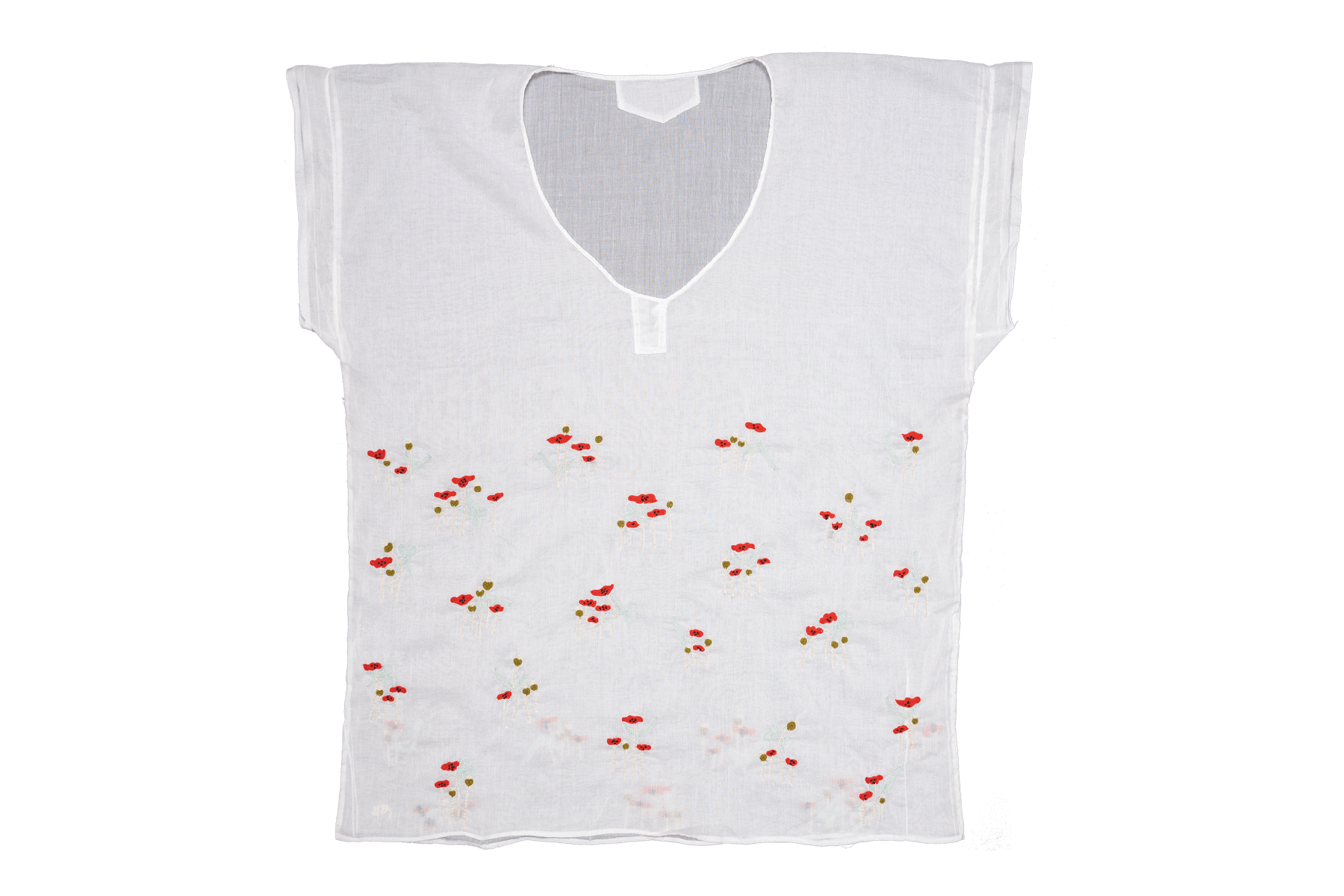Areez Katki b. 1989
Massacre of the Tall Poppies, 2018
Cotton thread hand embroidery on cotton mul sudreh
(HSN Code: 970110)
(HSN Code: 970110)
26.9 x 25.9 inches [variable]
Copyright Areez Katki, 2018
'Note about sudrehs: these are spiritual inner garments made of fine, often hand-woven, cotton muslin. Usually worn underneath clothing with a hand-woven prayer girdle called the ‘Kushti’ that is tied...
"Note about sudrehs: these are spiritual inner garments made of fine, often hand-woven, cotton muslin. Usually worn underneath clothing with a hand-woven prayer girdle called the ‘Kushti’ that is tied three times across the waist as part of a daily Zoroastrian prayer ritual. The garment is also worn alone, by Parsi men on intimate occasions when it is very hot at home. Two sudrehs have been made in the artist’s size using the men’s format of stitches; symbolically, each little seam and patch signifies various ‘daily reminders’ of the Zoroastrian doctrine, ‘Good Thoughts, Good Words, Good Deeds’. Ask any Parsi to explain what these discreet seam stitches mean.
This sudreh contains a dark and humourous attempt to layer two very distinct narratives: Firstly, from the sources of early 18th Century Parsi merchants who were hired by the East India Trade Company during the British Raj to source opium from the Far East – the opium poppy, Papaver Somniferum, it's flowers and pods. Secondly, a sociological phenomena known as ‘Tall Poppy Syndrome’ which (from the artist’s personal observations) has been prevalent in both, Parsi society and around creative communities in Aotearoa New Zealand. We see poppies cut down with scissors and scythes across the lower-torso motif of this garment, as a way to critique the social and political phenomenologies of exploitation, toxic masculinity and exhaustion, which pervade generations of a small migrant minority. "
This sudreh contains a dark and humourous attempt to layer two very distinct narratives: Firstly, from the sources of early 18th Century Parsi merchants who were hired by the East India Trade Company during the British Raj to source opium from the Far East – the opium poppy, Papaver Somniferum, it's flowers and pods. Secondly, a sociological phenomena known as ‘Tall Poppy Syndrome’ which (from the artist’s personal observations) has been prevalent in both, Parsi society and around creative communities in Aotearoa New Zealand. We see poppies cut down with scissors and scythes across the lower-torso motif of this garment, as a way to critique the social and political phenomenologies of exploitation, toxic masculinity and exhaustion, which pervade generations of a small migrant minority. "
Exhibitions
Bildungsroman (& Other Stories), TARQ, Mumbai, 2021Literature
Firstpost, Bildungsroman (& Other Stories) | Areez Katki on first solo show, and using art to explore notions of home, identity, July 22 2021https://www.firstpost.com/art-and-culture/bildungsroman-other-stories-areez-katki-on-first-solo-show-and-using-art-to-explore-notions-of-home-identity-9805721.html
Mid-day, 'Humble refugees, colonial villains' -- Mumbai-origin artist unpacks his Parsi roots in new show, July 22 2021
https://www.mid-day.com/lifestyle/culture/article/humble-refugees-colonial-villains-mumbaiorigin-artist-unpacks-his-parsi-roots-in-new-show-23184181
GQ, 4 new art shows in Mumbai to check out, Aug 3 2021
https://www.gqindia.com/get-smart/content/4-new-art-shows-in-mumbai-to-check-out
ArtAsiaPacific, Divinely Quotidian: Interview with Areez Katki, 6 August 2021
http://artasiapacific.com/Blog/DivinelyQuotidianInterviewWithAreezKatki
MASH, COMPLEXITIES OF SOCIAL IDENTITIES & ‘OTHER STORIES’, August 14, 2021
https://mashindia.com/complexities-of-social-identities.php
